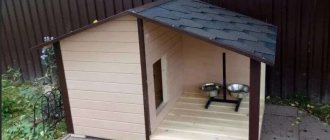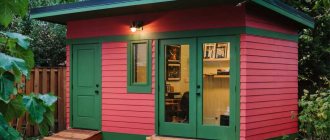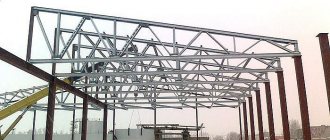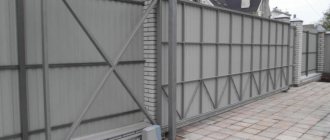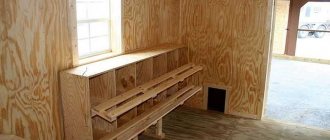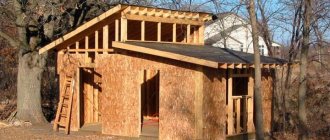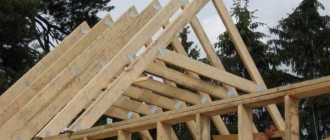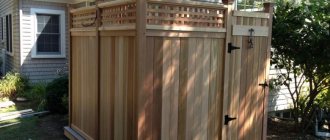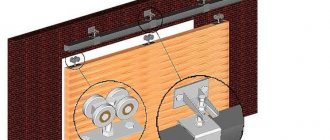Design options
The simplest house for an animal is a box with a hole and a gable or pitched canopy roof. Inside, the dog sleeps or hides from the weather. You can build such a booth in just a few hours. To keep the floors dry, the structure must be installed on a plank board or slatted pallet.
A more complex model is a two-section building, consisting of an insulated part and a small cold vestibule or canopy. Here the pet can not only rest, but also view the area from under the shelter.
A multifunctional option - a booth with a canopy, a built-in compartment for storing food, a stand for a feeder and a drinking bowl. The house can also be equipped with additional options - heating, lighting and even remote opening.
The dog enclosure deserves a separate discussion. It is made in the form of a space fenced with a mesh, where the animal can move and lead a freer lifestyle than sitting on a chain. Often the booth is installed in an enclosure or arranged as a single structure with a common frame and canopy. This option is optimal for large, active dogs with a restless character and excess energy.
Drawing and diagram
Before you build a kennel, you need to submit a drawing of it! It is not necessary to draw up a special drawing for the booth, since the design is not complicated. You can simply draw a diagram on a simple sheet of paper and determine the dimensions of the structure on it.
If you want to build a booth with exact dimensions, then a drawing is necessary. To complete the drawing correctly, you need to consider the following nuances:
- the interior space should be spacious enough for the dog to turn around freely. If a kennel is made for a puppy, then you need to understand that he will grow up very soon, so it is better to build a large kennel right away;
- if you plan to build a warm kennel, then it is better to use wood as a material - it is practical, environmentally friendly and is an excellent heat insulator;
- if there are frosty winters in your region of residence, then it is better to prefer a kennel built as a sandwich panel with insulation between the walls;
- if a booth is being built for a large dog, then it is installed inside a special enclosure for a four-legged pet;
- It is also advisable to decide on the shape of the roof when drawing up the drawing. For a large dog, it is better to build a kennel with a pitched roof. Dogs love to lie on it in the summer. A gable roof is suitable for a small booth when you need to increase the usable area of the internal space.
Developing a drawing will help to provide for all the nuances of construction and the kennel for your four-legged friend will turn out to be of high quality and comfortable.
Place for a dog house
An animal living on the street perceives itself as a guardian of its property. Therefore, the first thing you need to pay attention to when choosing a place for a booth is to provide a good view of the area for the dog. It is optimal if the building is close to the gate or entrance to the house.
Secondly, the site should be located on a hill and not be flooded by precipitation. It’s good if trees grow nearby or there is some object protecting from the sun - a fence, wall or canopy.
The third factor is safety for visitors. A dog may bite or scare someone who comes to you. Unless you plan to live as an absolute recluse, provide at least a small zone of inaccessibility.
The dog will need to be fed, watered, and its area cleaned. Keep in mind that the animal smells and hair flies from it, so you should not place the booth next to a place of rest, drying clothes or storing food. A certain sanitary zone must also be maintained between the dog and other domestic animals and poultry - goats, cows, chickens. There should be no access to the flower garden or vegetable garden, since many dogs dig in the ground and can damage or break the plantings.
Important points in the design of the booth.
There are two types of booths: insulated and non-insulated.
Simple kennels without insulation are suitable for dogs living in warm climates where winters are not so harsh. In cold climates, the booth must be insulated. Insulation, in addition to its main function, covers all the cracks. Foam plastic, polystyrene foam or mineral wool can be used as insulation. Mineral wool must be wrapped in a vapor barrier, otherwise over time it will attract moisture and lose its thermal insulation properties. The optimal insulation thickness is at least 5 cm.
It is not necessary to insulate the floor in the booth. In winter, the bedding will serve as insulation. And in summer, the coolness from the ground will reduce the temperature in the booth.
If possible, it is best to make a hole in the booth offset relative to the center of the booth. This way, the room will be less airy and the dog will have a cozy and warm sleeping place.
Dogs by nature tolerate cold more easily than drafts. Therefore, it is important that the booth has no cracks into which the wind can blow. In order to protect the entrance of the booth from the wind, they are made with a vestibule.
Booth with vestibule
Drawing of a booth with a vestibule.
Between the vestibule and the main room there should be a threshold 10-15 cm high. This threshold additionally protects from the cold and keeps the bedding inside the booth. If the booth is made without a vestibule, then there must be a threshold at the entrance to it.
Regular hay or straw should be used as bedding. Straw can be purchased at pet stores. There it is sold in briquettes. The litter needs to be monitored and changed from time to time. Do not use old rags or any carpet as bedding. The dog will carry snow into the kennel on its paws and, over time, the rag bedding will turn into an ice lump.
In winter, the entrance to the booth must be covered with a curtain made of two pieces of felt or old carpet, fixed overlapping. It is best to secure the curtain from inside the booth. Then it will normally block the hole after the dog has entered the kennel. If the curtain is secured from the outside, it may turn out that it will partially go inside the hole and remain in this position. As a result, the hole will not be completely closed.
It is best to make the roof of the booth removable and flat with a slight slope on one side. The roof can be made without a slope, but then the booth will need to be positioned with a slight slope relative to the ground level. Dogs love to lie on high ground. Therefore, the flat roof of the booth is an ideal additional place for relaxation. The roof should be covered with roofing felt in 2-3 layers. A removable roof is needed for convenient cleaning in the booth. The roof must be insulated. This will reduce heat loss in winter and will protect the interior of the booth from overheating in the summer heat.
Design and drawings of a dog house
To make it simple and clear how to build a house for your pet, it is advisable to think through the design of the structure in advance.
Factors that are taken into account when developing a building model:
- estimated number of animals;
- optimal sizes based on breed parameters;
- materials for walls, flooring, roofing;
- desired design.
Although the booth is a simple structure, a drawing or diagram drawn up will greatly facilitate all the work. Draw a plan, facades (if they are different), calculate the amount of materials that will be needed. You may have enough leftovers from building a house or shed.
The roof is usually made of a pitched or gable roof. For periodic cleaning and disinfection of dog housing, you can provide a folding mechanism or a removable option. To prevent the dog from lying on the damp ground outside the kennel, a boardwalk is laid in front of the hole.
Drawing of a booth with a pitched roof
Walls, floors and roofs are often insulated with inexpensive insulation materials - expanded polystyrene, polystyrene foam, felt, mineral wool. To protect the thermal insulation from dog teeth, the inside of the building is sheathed with lath, plywood, and OSB.
Exterior finishing can be anything - budget board, plywood or more expensive lining with clapboard, siding, brick.
In order for the booth to fit the size of the animal, it must be roomy, but not too spacious. Special tables indicate the parameters of various breeds that will be needed to determine the main dimensions of the booth.
Table of kennel sizes for different sizes of dogs
The recommendations of experienced dog breeders are as follows:
- width - no less than the height of the dog at the withers;
- depth - length from head to base of tail;
- height - height to the top of the head;
- Laz - slightly less than the width of the chest and the height at the withers.
With this size of the room, the dog will be able to freely lie down, stand up and go outside. A small hole will allow her to feel quite protected while sleeping.
You can measure your pet and make a house taking into account its individual parameters. For a young puppy, leave some reserve for growth.
Dog house dimensions
At the first stage of building a home for a dog, you need to decide on its size. They depend on the size of the pet. An animal can belong to one of 3 types.
Practice has shown that the following parameters are suitable for each type of dog:
- The size of the kennel for small dogs such as a pug, terrier or spaniel is 55 cm wide, 70 cm long and 60 cm high. The opening size is 30 by 40 cm.
- For medium-sized animals, such as Shar Pei, Foxhound or Basset Hound, the dimensions of the booth are 75 cm wide, 120 cm long and 80 cm high. The opening size is 35 by 50 cm.
- A booth for dogs of large breeds, which include Alabai, Mountain Dog or Dalmatian, width 100 cm, length 140 cm and height 95 cm; The size of the hole is 40-50 by 60 cm.
The actual dimensions of the animal and the table do not always coincide. If the booth is being made for a puppy who is still growing, you can use the table measurements.
The dimensions of the booth vary depending on the actual dimensions of the animal. Some animals have non-standard dimensions, in such cases it is better to take individual measurements. The pet's chest should fit freely into the hole. The Alabai breed is distinguished by its large dimensions. The dimensions and drawing of the Alabai booth are determined only after taking measurements from the animal.
When making calculations for the hole, it is worth measuring the dog’s chest and adding 5-8 cm. The height of the hole is equal to a value that is less than 5 cm of the animal’s height at the withers. The maximum depth and vertical size make it 5 - 8 cm greater than the height of the dog at the withers.
How to build a canopy booth
If the dog lives outside only in the summer and spends the winter in a house or apartment, a light canopy is enough to protect it from rain and sun. For construction you will need racks, crossbars, and roofing material. The frame can be built from the remains of timber or a profile pipe, the roof - from corrugated sheets, slate, or metal tiles.
The dimensions of the structure are arbitrary. The posts are dug into the ground and connected to each other by upper and lower trim. The frame does not need to be buried. But to prevent gusts of wind from overturning the lightweight building, it is secured to the ground using metal L-shaped rods. Instead of a floor, a wooden board and bedding are laid.
Such a canopy can become a temporary home for a dog during the construction of a real booth. And if the dimensions of the shelter allow, it is enough to subsequently fence it off with a net - and you will get a universal enclosure.
Heating in the booth: is it too much?
Well, that's how to say it. For example, back in 2012, ClimateRight offered an air conditioner for dog kennels. So, heating is not a luxury, but quite a necessity. Seriously though, there is an opportunity and it’s not that expensive. Although, most likely, this approach will be useful only for the coldest regions. How to make heating in a booth?
You can create a heating system using “warm floor” technology. This approach requires pouring the base. To create an electric heated floor you need:
- Pour the first layer of screed;
- Lay a layer of polystyrene foam;
- Lay the electrical cable;
- Fill the cable with a second layer of screed.
Of course, this approach is quite expensive, but it would also be wrong not to mention its existence.
Video: how to make heating in a kennel
Pallet booth
The unnecessary pallets from building materials available on the farm are quite suitable for the construction of dog housing. You will need 4-5 pallets, nails or screws, and insulation.
The pallets must first be disassembled and sorted by size. It is not recommended to use rotten slats with fallen knots; they will quickly become unusable.
Leave one pallet under the flooring. Assemble the frame from the bars. To attach the thermal insulation, first hem the strip from the inside. Place insulation in the niches, such as polystyrene foam or mineral wool. Finish the outside with lath. Secure the house to the pallet. Install roofing material. An economical, warm house for a dog is ready.
Barrel booth
A simple and inexpensive way to provide a home for your dog is to make a doghouse from an old barrel. This is an almost ready-made room that requires a minimum of modernization. You can use containers made of wood, metal or plastic, the main thing is that petroleum products or toxic substances have not been stored in it before.
The barrel is placed on its side. Fixed with stable supports - bricks, blocks, etc. A hole of the appropriate size is cut out in the lid. If it is not there, you can attach a cover with a hole to the end of the container. Bedding is laid inside - and the barrel booth is ready to receive a new tenant.
House for a guard
Guard dog breeds are usually large in size. German and Caucasian Shepherds, Giant Schnauzers, Moscow Watchdogs, Alabais and others perform excellently in this field. You will have to build a rather large booth for such giants.
Optimal sizes:
- height - 80-130 cm;
- width - 60-100 cm;
- length - 110-180 cm.
- hole - from 40x50 cm to 50x60 cm.
Large dogs require not only a large house, but also the organization of free space around it for physical activity. Around the booth you can install an enclosure, build in stairs and other exercise equipment, where the dog can maintain good physical shape and spend excess energy.
Small dogs - Airedale Terriers, Middle Schnauzers, Jagd Terriers - can also be excellent guards. All of them feel great in outdoor conditions, having a thick coat of fur. However, prolonged cold can harm your pet’s health, so the kennel must be insulated for frosty winters. Young animals are especially sensitive to low temperatures, since their immunity is still developing.
Booth made of blocks or bricks
The main advantages of such a house are strength and durability. More than one generation of guard dogs can be raised in a brick or block kennel.
To support heavy walls, you will need a foundation, which is made in the form of a reinforced concrete strip. The masonry is carried out in half a brick with bandaging of the seams using cement-sand mortar or special frost-resistant glue for blocks.
A jumper made of a metal corner is mounted above the opening. If you have the skills to lay arches, even the simplest brick box can be effectively decorated with a rounded opening. The inside of the booth is insulated. Wooden flooring is laid on the floor. Thanks to the stone’s ability to keep cool, the dog will be comfortable in such a house not only in winter, but also in summer.
How can you insulate a dog's kennel for the winter?
Some use electric heating. Of course, if possible, you can install 2 cm thick heating plates inside the wall. But in practice, owners resort to more affordable methods.
How to insulate a dog house for the winter with straw
The active use of straw for insulating kennels is explained by the availability of the material and its ease of use. To make bedding, you should choose straw with a hard stem (wheat, rye). Reeds are also suitable for these purposes, while oat straw will be of little use. Such bedding will have to be replaced once a week; if possible, it would be good to shake it daily.
To keep the dog warm, the layer of straw must be dense enough. This is necessary to penetrate the lower layers of moisture so that the top remains dry as long as possible. When the top layer gets wet, the straw must be renewed. The versatility of this bedding is that it is suitable for any age of dog.
How to insulate a doghouse with polystyrene foam
Sheets of foam plastic can be used on single-layer walls and floors, without further cladding. But this should be done from the outside, otherwise the dog inside the booth may simply chew it. Thermal insulation should be mounted on adhesive foam with good adhesion. Considering the fact that the material is afraid of ultraviolet radiation, and its structure is destroyed, you need to either paint it or sew it up with plywood or boards.
Polystyrene foam is not prone to caking and absorbing moisture; it is excellent for insulating a booth for the winter
If the booth has two-layer walls, then the insulation is installed in the space between the walls. There is no waterproofing or finishing required here. Thanks to this simple technique, the kennel will be cool in the summer and warm in the winter.
How to properly insulate a dog house with penoplex
The principle of laying penoplex is the same as with polystyrene foam. It can either be glued to the walls of the booth, or fixed with screws. It is better to cover the thermal insulation layer with OSB boards, plywood or clapboard - both inside and outside.
How to insulate a dog’s kennel for the winter with mineral wool
The technology for laying mineral wool in a booth has the same principles as when insulating a loggia or balcony. Here you will need the following materials and tools:
- several bushes of mineral wool (according to the internal dimensions of the house);
- wooden blocks;
- plywood sheets;
- vapor barrier fabric;
- nails;
- a regular construction stapler.
To carry out work on thermal insulation of a dog house using mineral wool, you must adhere to the following instructions:
- Dismantle the roof. Place the first layer of vapor barrier on the walls and secure it with a stapler.
- Install a sheathing of wooden blocks on the walls of the booth. Place pieces of mineral wool cut to size in the space between the bars.
- Fix another layer of vapor barrier fabric.
- Cover with sheets of plywood or OSB.
Important! Since the use of mineral wool involves reducing the internal area of the dog house, this point should be foreseen in advance before using it.
How to insulate a doghouse with felt
To insulate the booth you will have to prepare:
- roll of artificial felt;
- sharp knife/scissors;
- fasteners.
The algorithm for performing thermal insulation work consists of the following actions:
- Prepare a drawing of an insulated dog house with or without a canopy.
- Take measurements of the floor, walls, roof. Cut the felt according to specific dimensions.
- The material is fixed with nails. The walls are insulated first, and then the floor and roof.
- At the end of the work, bedding is laid on the floor. Since felt does not pose any threat to the health of a pet, it is not necessary to sheathe it over it.
How and how to insulate a booth
Thermal insulation helps the dog stay warm in cold weather and keeps the room somewhat cool on hot days.
For insulation use:
- polystyrene foam, polystyrene foam;
- mineral wool;
- felt.
To protect against blowing, the opening is closed with a curtain. In emergency cases, for example, in very severe cold or when puppies are born, electric heating is used using infrared mats. They are fixed to the ceiling of the booth and connected to a power source.
Straw or shavings are suitable for bedding. They are hygroscopic and retain heat well. Against parasites, it is recommended to add waste from coniferous trees, which has a repellent and antibacterial effect. The bedding should be changed once a month, and during the summer, in the absence of the animal, the room should be disinfected and dried.
How to build a dog house with your own hands from timber, plywood or OSB
To make a house measuring 100x100x100 cm you will need:
- timber 50x100, 100x100 mm;
- board scraps;
- Penoplex insulation 40-50 mm thick;
- plywood or OSB;
- lining for finishing;
- remnants of metal tiles;
- fasteners;
- paint and varnish composition for exterior work.
Frame making
It is a cube with a side of 100 cm. We cut the bars into 1 meter pieces. For now, we will only make the frames, and we will assemble them on the finished base. We will make a separate frame for the retractable roof.
Booth base
We lay 2 beams with a cross section of 100x100 mm and a length of 1.4 m on a flat area.
We nail the floor boards on top. The shield turns out strong and stable.
We fix the lower frame to the flooring.
We insulate with expanded polystyrene, fill the seams with polyurethane foam.
Sheathing preparation
We cut out plates from the OSB sheet that are equal in size to the roof, rear and side walls.
House assembly
We fix OSB on all frames.
We install it in the design position.
We cut a hole in one of the walls and screw bars around its perimeter to secure the sheathing.
Insulation and exterior finishing
We attach penoplex.
We will use wooden lining, which we nail to the frame on top of the insulation with finishing nails. You should not attach the slats too tightly to each other so that they do not warp when moistened and swollen.
Canopy assembly
We have provided a gable roof over the booth. We install racks.
We install the rafter system.
First, we cover the gables with clapboard so that we can cut it in place, and not measure out each plank on the ground.
We attach the sheathing to the rafters.
We cut out 4-meter pieces from the remnants of the metal tiles and lay them on the roof. We cut off the protruding sheathing with a saw. For the ridge, we bend the strip of tiles longitudinally, install it on the roof and screw it on.
Finishing
The work is completed by painting the wood with yacht varnish. It makes the wood resistant to moisture and sun, and extends the life of the finish.
You can bring your pet into a finished kennel with a removable roof and canopy.
Basic requirements for thermal insulation of a kennel
First, you need to understand one important point: we are talking about a creature that is guided, first of all, by its own instincts. It is impossible to explain to him what can and cannot be done. Therefore, you need to follow certain requirements.
The walls of an insulated kennel should not be such that they can be easily damaged.
It is better to give preference to natural heat insulators that emit a minimal amount of harmful substances into the atmosphere.
A great idea is to arrange a canopy. It is important that it is very durable, because the dog will most likely want to play with it. Vinyl or regular tarpaulin most likely will not be able to hold out for long (more details about the canopy in the next paragraph of the article).
Finally, the insulation should be properly insulated from the interior of the kennel. Mineral wool, for example, irritates the human respiratory system, and there’s nothing even to say about a dog’s sensitive sense of smell.
Now let’s find out how to insulate a dog house and what materials to use for this.
Installing a curtain (canopy) in a kennel
The hole in the kennel should be protected from the penetration of precipitation - this will require a special curtain. Often, tarpaulin or rubber is used to make it. Also, the curtain should be weighted somewhat so that it does not flutter from the wind. You can, for example, sew small pockets to the bottom of it and pour sand into them.
By the way, today ready-made canopies or curtains are also sold; they can be found in many specialized stores.
How to insulate a frame house
Previously, we talked about several options for insulating a frame house and described the entire process in detail; in addition to this article, we advise you to read this information and read about it here
Choosing insulation for a dog house
When choosing a particular insulating material, you should be guided, first of all, by what the booth itself is made of (it can be slabs, wood, and so on). Let's consider the possible options.
Option #1. Minvata
This is perhaps the most popular insulating material today, which, however, should be used with extreme care to insulate a kennel. This is explained by the fact that the dog can destroy the insulating layer, causing it to lose its original characteristics. Moreover, this can harm the health of the animal itself. Finally, due to the small size of the dog house, the isolation procedure will be troublesome and time-consuming.
However, if you still prefer mineral wool, then use it in accordance with the following requirements.
- Never use glass wool.
- The insulating layer must be waterproofed.
- Finally, there must be cladding, no matter what the exterior/interior decoration is.
Option #2. Styrofoam
An excellent thermal insulator for use in a kennel. First of all, its thermal insulation parameters are no worse, and in some cases even better, than those of mineral wool. In addition, foam plastic is not so susceptible to external influences, therefore, it does not need waterproofing in principle.
If you like polystyrene foam for insulating a booth, then you should know what types there are. Here they are:
- penoplex;
- expanded polystyrene.
Although the dog, be that as it may, will gnaw and scratch the heat insulator, which means that it will still have to be covered with something.
Option #3. Roll type heat insulators
Another option suitable for insulating a kennel is rolled thermal insulation materials. This could be, for example, ordinary polyethylene, which is quite easy to attach to the surface even with a stapler (although there are also modifications of the film that are already on an adhesive base). Penofol has similar characteristics.
All of these materials have excellent thermal insulation properties, but, again, they require additional cladding.
Option number 4. Felt
This is a material of natural origin, characterized by safety and an affordable price. In a word, this is an ideal option for a kennel.
We also note that it is vapor-tight, which means that moisture will not accumulate (the booth will always be dry). It is not blown by the wind. Finally, it does not need to be covered with anything, and ordinary nails can be used for fixation (the main thing is that the heads are large).
Video - Thermal insulation of a pet booth
Instructions for insulating the booth
Now let's talk directly about how to insulate a doghouse. The procedure consists of several stages; let’s look at each of them in more detail.
Stage No. 1. Bottom and floor of the kennel
Step one. First, the floor is insulated and the bottom is protected. For this purpose, the structure is turned upside down, all surfaces are treated with a special substance (it will protect them from destruction) and covered with roofing felt (the latter, by the way, can be secured with wooden blocks). So, the external floor protection in the kennel is ready.
Step two. The booth is turned back over and the insulation procedure continues. First, the floor is covered with a waterproofing film (as an option, you can use the same roofing material for this). The material is laid with slight overlap to avoid the appearance of cracks. The joints are shot with a mounting stapler. It is also advisable that the film be extended a few centimeters onto the walls.
Step three. After this, a layer of insulation is laid, which, in turn, needs to be covered. If you are using a soft heat insulator or a large volume, then it is preferable to fill some miniature analogue of logs from the bars so that you can build a finished floor.
Step four. The finishing floor is being laid. It can be constructed from pre-processed boards or, alternatively, plywood or OSB boards.
Step five. It is also advisable to carry out additional insulation work that will protect the kennel from freezing or leaking. Where the structure will be installed, a hole 20 centimeters deep is dug along its perimeter, an expanded clay or gravel “cushion” is poured into it, and an insulating layer (roofing felt or ordinary film) is laid on top with a slight approach to the surface. If insulation is carried out from the outside, the film is hemmed under the facing material. When installing the kennel on this type of base, freezing of the floor, as well as the flow of moisture inside, is minimized.
Stage No. 2. Wall construction
Let’s immediately make a reservation that the procedure for insulating walls depends on the specific material that is used for this. Simply put, you need to act in strict accordance with the manufacturer's instructions. Below is just a brief step-by-step instruction.
Step one. The walls are cleaned and treated.
Step two. If necessary, a waterproofing layer is laid.
Step three. Insulation material is installed.
Step four. If necessary, additional vapor barrier material is attached.
Step five. The walls are finished (if required by the type of heat insulator used).
Note! The main condition for thermal insulation of a dog kennel is the following: it is unacceptable to have blown areas in the structure, as well as for moisture to penetrate inside.
Stage No. 3. Ceiling, roof
A ceiling-roof (that is, a single structure, in one design) is suitable for a kennel, which will be located under a canopy in a special enclosure (where water cannot leak), if not, then it is preferable to build a pitched roof for the kennel, but it is mandatory removable type order. This is one of the mandatory points on how to insulate a dog house.
A kind of “attic” of the roof is insulated in the same way that the floor was insulated. First, a polyethylene film is attached for waterproofing, followed by insulation material. An important point: here the insulation installed in the roof does not need to be protected, since the dog will not have access to it in principle. It is also recommended to protect the internal slopes from water and wind - cover them with insulation or insulation around the perimeter.
